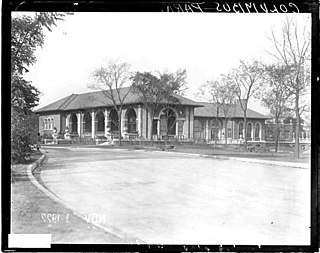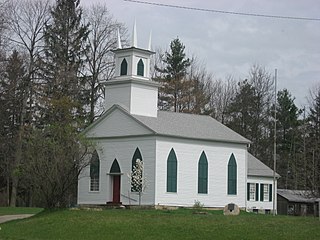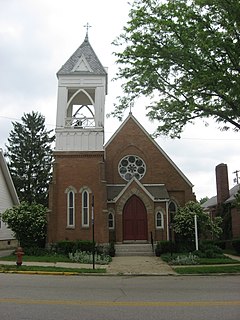
Dwight is a village located mainly in Livingston County, Illinois, with a small portion in Grundy County. The population was 4,260 at the 2010 census. Dwight contains an original stretch of the famous U.S. Route 66, and from 1892 until 2016 continuously used a railroad station designed in 1891 by Henry Ives Cobb. Interstate 55 bypasses the village to the north and west.

Carpenter Gothic, also sometimes called Carpenter's Gothic or Rural Gothic, is a North American architectural style-designation for an application of Gothic Revival architectural detailing and picturesque massing applied to wooden structures built by house-carpenters. The abundance of North American timber and the carpenter-built vernacular architectures based upon it made a picturesque improvisation upon Gothic a natural evolution. Carpenter Gothic improvises upon features that were carved in stone in authentic Gothic architecture, whether original or in more scholarly revival styles; however, in the absence of the restraining influence of genuine Gothic structures, the style was freed to improvise and emphasize charm and quaintness rather than fidelity to received models. The genre received its impetus from the publication by Alexander Jackson Davis of Rural Residences and from detailed plans and elevations in publications by Andrew Jackson Downing.

The Benjaminville Friends Meeting House and Burial Ground is a Friends Meeting House of the Religious Society of Friends (Quakers), located north of the rural village of Holder in McLean County, Illinois. It was once the site of a now-defunct village called Benjaminville, founded in 1856 after Quakers settled the area. More Quakers followed, and the burial ground, then the current meeting house in 1874, were constructed. This site, listed on the U.S. National Register of Historic Places since 1983, is all that remains of that village.

Columbus Park is a 135-acre (55 ha) park located on the far West Side of Chicago, Illinois in the Austin neighborhood. It is considered the finest work by landscape architect Jens Jensen and was consequently named a National Historic Landmark in 2003.

As of 2007 there are five church buildings in the Sycamore Historic District, located in Sycamore, Illinois, United States which are listed as contributing properties to the district. The Sycamore Historic District was added to the U.S. National Register of Historic Places on May 2, 1978. When it was nominated to join the National Register there were seven church buildings within the district. One of those included is a residential structure that was utilized as a church when it was first constructed; the Arthur Stark House was once home to the Sycamore Universalist Church congregation. In the time since its listing, two churches have been destroyed or demolished. The Evangelical Church of St. John was destroyed by fire in 2004 and the United Methodist Church in Sycamore is no longer extant, replaced by a modern office building.
Minard Lafever (1798–1854) was an American architect of churches and houses in the United States in the early nineteenth century.

Ambler's Texaco Gas Station, also known as Becker's Marathon Gas Station, is a historic filling station located at the intersection of Old U.S. Route 66 and Illinois Route 17 in the village of Dwight, Illinois, United States. The station has been identified as the longest operating gas station along Route 66; it dispensed fuel for 66 continuous years until 1999. The station is a good example of a domestic style gas station and derives its most common names from ownership stints by two different men. North of the station is an extant outbuilding that once operated as a commercial icehouse. Ambler's was the subject of major restoration work from 2005–2007, and reopened as a Route 66 visitor's center in May 2007. It was added to the U.S. National Register of Historic Places in 2001.

The Ephraim Smith House is an 1845 Greek Revival house in the village of Sugar Grove, Illinois, United States. The house was built by Ephraim Smith, a millwright from Vermont. It is the only example of a wood framed Greek Revival rural house in Kane County that remains in its unaltered state. The house has, however, been moved from its original location. The Ephraim Smith House was added to the U.S. National Register of Historic Places in 1980.

St. Andrew's Episcopal Church, also known as St. Andrew's Church is a historic church building on County Highway 12 in Prairieville, Alabama. Built by slaves in 1853, it is a remarkably well-preserved example of Carpenter Gothic architecture, its design apparently taken from a book by Richard Upjohn. St. Andrew's was added to the National Register of Historic Places on November 7, 1973, and was declared a National Historic Landmark on the same day. Public access is allowed to this National Historic Landmark.

St. Joseph Shrine, founded in 1855, is a historic German Catholic church located at 1828 Jay Street in the Eastern Market–Lafayette Park neighborhood area just outside downtown Detroit, Michigan, on the city's central east side. The building was listed on the National Register of Historic Places in 1972, and deemed "of national importance" because of its stained glass. Three subsidiary buildings—the rectory, convent, and the Wermers House—were added to the listing in 1992. It is a parish of the Archdiocese of Detroit, and presently a shrine dedicated to the celebration of the pre-Vatican II liturgy under the care of the canons of the Institute of Christ the King Sovereign Priest.

The former First Baptist Church is a historic Baptist church building located at 8601 Woodward Avenue in Detroit, Michigan. Built in 1909, it was designed by architect Guy J. Vinton in the Late Gothic Revival style. It is now the Peoples Community Church. The building was added to the National Register of Historic Places on August 3, 1982.

Salem First United Methodist Church is a Methodist congregation and historic church in Salem, Oregon, United States. The church was listed on the National Register of Historic Places under its original name, First Methodist Episcopal Church of Salem, in 1983. First United is the oldest Methodist church west of the Rocky Mountains, and is a designated United Methodist Heritage Landmark. It is one of Oregon's few high-style Gothic Revival churches outside of Portland, and has one of the rare tall spires left standing in the state.

The Scales Mound Historic District is a historic district in the small Illinois village of Scales Mound. The district encompasses the entire corporate limit of the village and has more than 200 properties within its boundaries. The district was added to the U.S. National Register of Historic Places in 1990.

The Gethsemane Evangelical Lutheran Church is a church located at 4461 Twenty-Eighth Street in Detroit, Michigan. It was designated a Michigan State Historic Site in 1980 and listed on the National Register of Historic Places in 1982. The building now houses the Motor City Missionary Baptist Church.

St. Paul's Episcopal Church is a historic Carpenter Gothic style Episcopal church building located on a triangular lot at 416 Southeast Grand Avenue at the corner of Fifth and Green streets in Lee's Summit, Missouri, United States. The parish was established in 1867. The original sanctuary and current building were designed by the Rev. Frederick B. Scheetz and completed in 1884. The building is a rare example of an extant wood framed Carpenter Gothic church in the state of Missouri. The interior walls and vaulted ceilings are covered with narrow strips of wood paneling set diagonally on the walls and horizontally on the ceiling. A trio of stained glass windows is set above the wooden altar in the apse at the north end of the transept. The church has received few if any alterations since it was built in 1884.

Windsor Mills Christ Church Episcopal is a historic former church building in Windsor Township, Ashtabula County, Ohio, United States. Built in the 1830s, it features a distinctive combination of two different architectural styles, and it has been named a historic site.

The Church of Our Saviour is a historic Episcopal parish in the village of Mechanicsburg, Ohio, United States. Founded in the 1890s, it is one of the youngest congregations in the village, but its Gothic Revival-style church building that was constructed soon after the parish's creation has been named a historic site.

Second Baptist Church is a historic church building in the village of Mechanicsburg, Ohio, United States. Constructed in the mid-19th century, it is the oldest church in the village, and it has been named a historic site.

The George M. Brown House is a historic residence in Provo, Utah, United States, that is listed on the National Register of Historic Places. It was built as a home for a "polygamous wife" of lawyer George M. Brown. It is listed on the National Register of Historic Places.

The Church of the Holy Innocents is a heritage-listed Anglican church at 130 Rossmore Avenue West, Rossmore, City of Liverpool, New South Wales, Australia. It was designed by Richard Cromwell Carpenter and Edmund Blacket and built from 1848 to 1850 by William Munro. The property is owned by Anglican Church Property Trust Diocese of Sydney. It was added to the New South Wales State Heritage Register on 24 August 2018.






















